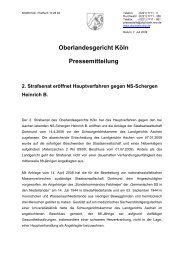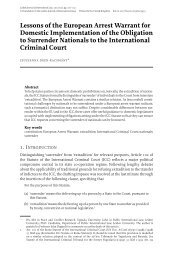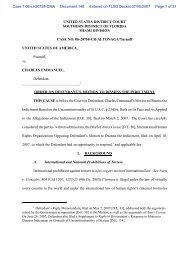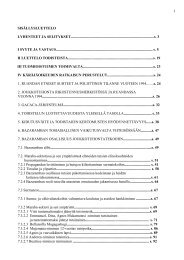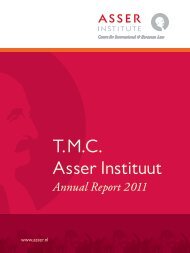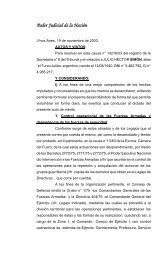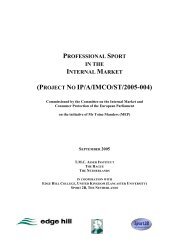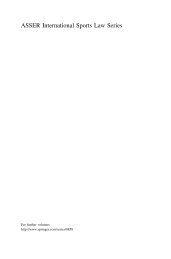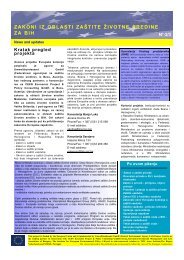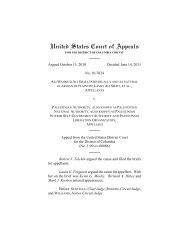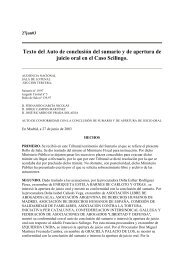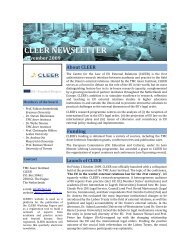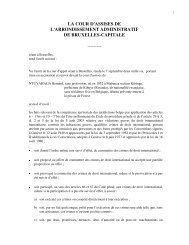Islj 2009 3-4 - TMC Asser Instituut
Islj 2009 3-4 - TMC Asser Instituut
Islj 2009 3-4 - TMC Asser Instituut
You also want an ePaper? Increase the reach of your titles
YUMPU automatically turns print PDFs into web optimized ePapers that Google loves.
The Future EU Sports Policy: Hollow<br />
Words on Hallowed Ground?<br />
by An Vermeersch*<br />
The Treaty on the functioning of the European Union stipulates that the<br />
Union will “contribute to the promotion of European sporting issues” and<br />
that the Union’s action “shall be aimed at developing the European<br />
dimension in sport” (Article 165 TFEU). Can this lead to a concrete EU<br />
sports policy? In reality, the answer lies in setting priorities and finding the<br />
legal tools necessary to achieve the goals set. To answer the question, a<br />
comparison is made between the priorities of the actors involved and the<br />
results in practice. In order to assess the Union’s future action in the field<br />
of sport, the current and future priorities and the legal framework provided<br />
by the TFEU are analysed.<br />
Introduction<br />
The evolution of the European Union’s sports policy is characterised<br />
by the dual mechanism that traditionally guides the European integration<br />
process: negative versus positive integration. 1 Negative (indirect)<br />
integration relates to measures increasing market integration by<br />
the removal of (national) trade barriers and obstacles to free movement<br />
and competition. Positive (direct) integration relates to common<br />
European policies with aims that go beyond the removal of these<br />
obstacles. In relation to the indirect EU sports policy, in particular the<br />
application of the European rules concerning free movement and<br />
competition to sport, a clear legal framework emerged. Even if this<br />
framework needs further refinement, with a prominent role for the<br />
case-by-case approach, it is unlikely that it will be subject to major<br />
changes. The future of the EU’s direct sports policy seems less obvious.<br />
Whereas it is clear that the EU is ‘active’ in the field of sport,<br />
these actions are very divers and can hardly be defined as a comprehensive<br />
European sports policy. 2<br />
This paper explores the possibility of a future (direct) EU sports<br />
policy. Rather than analysing the theoretical explanation for the evolution<br />
of the EU’s sports policy 3 or the changing relationship between<br />
the EU and the world of sport 4 , this paper focuses on the concrete<br />
actions in practice. Thus, a tentative agenda for the future (direct) EU<br />
sports policy will be outlined. First, a comparison is made between<br />
the priorities set forward by the different actors involved and the<br />
results in practice. Second, the limits of the future EU policy will be<br />
analysed on the basis of a (new) legal framework.<br />
Priorities versus results<br />
Search for priorities<br />
The origins of the direct sports approach go back to the 1984<br />
Fontainebleau European Council 5 and the Adonnino Report of the<br />
* Assistant Professor, European Institute,<br />
Ghent University. The author would like<br />
to thank Borja García, Kirstyn Inglis and<br />
Astrid Vervaet for their comments on an<br />
earlier version of this article. The usual<br />
disclaimer applies. Comments are welcome<br />
at An.Vermeersch@Gent.be.<br />
1 Parrish, ‘The Politics of Sports<br />
Regulation in the European Union’,<br />
(2003) Journal of European Public Policy,<br />
p. 250; Sharpf, ‘Negative and Positive<br />
Integration in the Political Economy of<br />
European Welfare States’, in Marks,<br />
Scharpf, Schmitter and Streeck (eds.)<br />
Governance in the European Union<br />
(SAGE Publications, London, 1996), p.<br />
15. On the distinction between indirect<br />
and direct sports policy, see Tokarski,<br />
Steinbach, Petry and Jesse, Two Players -<br />
One goal? Sport in the European Union<br />
(Meyer & Meyer, Oxford, 2004), p. 61.<br />
2 Van den Bogaert and Vermeersch, ‘Sport<br />
and the European Treaty: A Tale of<br />
Uneasy Bedfellows?, (2006) E.L.Rev., p.<br />
821-840.<br />
3 For an overview see Meier, Emergence,<br />
Dynamics and impact of European sport<br />
policy - perspectives from political science’,<br />
in Gardiner, Parrish and Siekmann<br />
(eds.) EU, Sport, Law and Policy.<br />
Regulation, re-regulation and representation<br />
(T.M.C. <strong>Asser</strong> Press, The Hague,<br />
<strong>2009</strong>), p. 7-33.<br />
4 García, ‘From regulation to governance<br />
and representation: agenda-setting and<br />
the EU’s involvement in sport’, (2007)<br />
Entertainment and Sports Law Journal.<br />
5 Conclusions of the Fontainebleau<br />
European Council (25-26 June 1984),<br />
European Parliament on ‘A People’s Europe’. 6 At that time, the<br />
Community’s policy concentrated on the potential of sport to achieve<br />
‘European goals’. Sport was in the first place considered as a forum for<br />
communication among peoples, as a tool to strengthen the image of<br />
the EU in the minds of its citizens. 7 Concretely, the Community’s<br />
involvement in the field of sport remained for the most part limited<br />
to the funding of international sporting competitions like the<br />
European Sailing Regatta or the Tour de l’Avenir in cycling. 8 After the<br />
adoption of the Single European Act in 1986, Community interest in<br />
the field of sport moved on to a broader social, educational and cultural<br />
plane and the first pleas for the development of a European<br />
sports policy emerged. 9 This evolution was further induced by the<br />
Bosman judgment, 10 and the reactions from the sports world to this<br />
case in particular. 11<br />
In order to get an overview of the - past and current - priorities of<br />
the EU’s involvement in the field of sport, an analysis is made of the<br />
‘sports agenda’ of the European institutions and the Member States.<br />
Three preliminary remarks should be made in this respect. First, this<br />
overview aims at illuminating general tendencies, rather than aiming<br />
at an exhaustive and detailed listing. As Commissioner Reding correctly<br />
pointed out in 2002, the latter would be difficult. 12 Second,<br />
whereas the correlation between the activities of the different actors<br />
should not be ignored, this overview makes a distinction between the<br />
priorities set forward by the Member States, the European Parliament<br />
and the European Commission respectively. Third, the sports world is<br />
not mentioned as a separate actor. This is not to say that the sports<br />
world does not play a role in the agenda-setting at EU level.<br />
The table 13 on page 4 lists the main agenda items of the successive<br />
EU presidencies over the 2000-2011 period. Three findings emerge.<br />
First, the activities of the Member States cover a great number of topics,<br />
ranging from non-profit sports organisations to the economic<br />
dimension of sport. Second, a number of issues can regularly be<br />
found on the agenda, with the fight against doping (including the<br />
relationship with WADA) and the broader discussion on the legal<br />
framework and the future evolution of the sports policy (including<br />
the follow-up of the Nice Declaration, the position of sport in the<br />
Treaty and the White Paper) as two ‘permanent’ agenda items. Third,<br />
a trend towards more coherence by the classification of topics can be<br />
observed. This is illustrated by the joint initiative of the European<br />
Commission and the Dutch presidency in 2004 to adopt a Rolling<br />
Agenda for Sport to define the priority themes for Member State discussions<br />
on sport at EU level. The Rolling Agenda includes the follow-<br />
Bulletin European Communities, 6-1984.<br />
6 Adonnino Report, ‘A People’s Europe’,<br />
Bulletin European Communities, 6-1985,<br />
Suppl. 7/85.<br />
7 Ibidem, 5.9.; European Parliament,<br />
Resolution on sport in the Community,<br />
13 April 1984, [1984] OJ C 127/142.<br />
8 Tokarski, Steinbach, Petry and Jesse,<br />
above n. 1, p. 62-63.<br />
9 European Parliament, Resolution on<br />
sport in the European Community and a<br />
People’s Europe, 17 February 1989, [1989]<br />
OJ C 69/234.<br />
10 Case C-415/93 Union Royale Belge des<br />
Sociétés de Football Association ASLB v<br />
Jean-Marc Bosman [1995] ECR I-4921.<br />
11 See for instance Parrish, Sports law and<br />
policy in the European Union<br />
(Manchester University Press,<br />
Manchester, 2003).<br />
12 In answer to a written question of MEP<br />
Theresa Zabell concerning a detailed list<br />
of all measures and actions connected<br />
with sport or with sportsmen and women<br />
during the term of office, the<br />
Commissioner stated: “[…] the<br />
Commission has not performed a general<br />
survey of all the sport-related initiatives<br />
undertaken during the current legislative<br />
period. This would be difficult to do,<br />
given the wide range of policies and initiatives<br />
concerned.”. See Written question<br />
E-1470/02 by Theresa Zabell to the<br />
Commission, Actions connected with<br />
sport, 27 May 2002, [2002] OJ C<br />
301E/154.<br />
13 For the sources where this table is based<br />
on, see Annex I.<br />
A RT I C L E S<br />
<strong>2009</strong>/3-4 3



